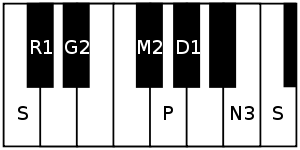Shubhapantuvarali
Shubhapantuvarali (pronounced śubhapantuvarāḻi, meaning the auspicious moon) is a rāgam in Carnatic music (musical scale of South Indian classical music). It is the 45th melakarta rāgam in the 72 melakarta rāgam system of Carnatic music. It is called Shivapantuvarāḻi in Muthuswami Dikshitar school of Carnatic music.[1][2] Todi (thaat) is the equivalent in Hindustani music.[2] Being sad in tone, it is usually used for sad songs by musicians.
| Arohanam | S R₁ G₂ M₂ P D₁ N₃ Ṡ |
|---|---|
| Avarohanam | Ṡ N₃ D₁ P M₂ G₂ R₁ S |
| Carnatic music |
|---|
Tanjavur-style Tambura |
| Concepts |
| Compositions |
| Instruments |
|
Structure and Lakshana

It is the 3rd rāgam in the 8th chakra Vasu. The mnemonic name is Vasu-Go. The mnemonic phrase is sa ra gi mi pa dha nu.[1] Its ārohaṇa-avarohaṇa structure (ascending and descending scale) is as follows (see swaras in Carnatic music for details on below notation and terms):
- ārohaṇa: S R₁ G₂ M₂ P D₁ N₃ Ṡ[lower-alpha 1]
- avarohaṇa: Ṡ N₃ D₁ P M₂ G₂ R₁ S[lower-alpha 2]
This scale uses the notes shuddha rishabham, sadharana gandharam, prati madhyamam, shuddha dhaivatham and kakali nishadham. As it is a melakarta rāgam, by definition it is a sampoorna rāgam (has all seven notes in ascending and descending scale). It is the prati madhyamam equivalent of Dhenuka, which is the 9th melakarta scale.
Janya rāgams
Shubhapantuvarali has a few minor janya rāgams (derived scales) associated with it. See List of janya rāgams for full list of rāgams associated with Shubhapantuvarali.
Compositions
Here are a few common compositions sung in concerts, set to Shubhapantuvarali.
- Ennalu urake by Thyagaraja
- Sri Satyanarayanam and Pasupatheeswaram by Muthuswami Dikshitar
- Pahimaam payoraasi varnam composed by Kalyani Varadarajan
- Karunanu Nanu kĀpĀdumu composed by Dr. M. Balamuralikrishna
- Sri Lakshmi Ramana Narayana composed by Narayana Raju
- Velane Vere Gati composed by Koteeswara Iyer
- ’’Paripalayam Shri Dasarathe’’ composed by Mysore Vasudevachariar
Film Songs
Language: Tamil
| Song | Movie | Composer | Singer |
|---|---|---|---|
| Kaala Magal | Anandha Jodhi | Viswanathan–Ramamoorthy | P. Susheela |
| Unnai Naan Santhithaen | Aayirathil Oruvan | ||
| Indha Naadagam | Palum Pazhamum | ||
| Aattuviththaal Yaaroruvar | Avandhan Manidhan | M. S. Viswanathan | T. M. Soundararajan |
| Poi Indri Meiyodu Nei Kondu Ponal | Swami Iyyapan | Chandrabose | K.J. Yesudas |
| Ayiram Thamarai | Alaigal Oivathillai | Illayaraja | S. P. Balasubrahmanyam, S. Janaki |
| Azhakindran Madhavan | Sri Raghavendrar | K.J. Yesudas, Malaysia Vasudevan | |
| Vaigaraiyil Vaigaikaraiyil | Payanangal Mudivathillai | S. P. Balasubrahmanyam | |
| Engey Nimmathi | Nadigan | ||
| Kandupudichen | Guru Sishyan | ||
| Moonu Mudichaala Muttala Aanen | Amman Kovil Kizhakale | Malaysia Vasudevan | |
| En Anbae En Anbae | Mounam Pesiyadhe | Yuvan Shankar Raja | Shankar Mahadevan |
| Kan Pesum Varthaigal | 7G Rainbow Colony | Karthik |
Related rāgams
This section covers the theoretical and scientific aspect of this rāgam.
Shubhapantuvarali's notes when shifted using Graha bhedam, yields a melakarta rāgam, namely, Chalanata. Graha bhedam is the step taken in keeping the relative note frequencies same, while shifting the shadjam to the next note in the rāgam. For further details and an illustration refer Graha bhedam on Chalanata.
Notes
- Alternate notations:
- Hindustani: S Ṟ G̱ M̄ P Ḏ N Ṡ
- Western: C D♭ E♭ F♯ G A♭ B C
- Alternate notations:
- Hindustani: Ṡ N Ḏ P M̄ G̱ Ṟ S
- Western: C B A♭ G F♯ E♭ D♭ C
References
- Ragas in Carnatic music by Dr. S. Bhagyalekshmy, Pub. 1990, CBH Publications
- Raganidhi by P. Subba Rao, Pub. 1964, The Music Academy of Madras